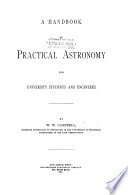 | John Thornton (M.A.) - 1890 - 372 pages
...from the pole of the ecliptic to the ecliptic itself. The length of the major axis simply expresses the ratio of the velocity of light to the velocity of the earth in its path and is therefore constant. It has been found by careful observation of the stars that this major... | |
 | William Wallace Campbell - 1891 - 190 pages
...direction of a star differs from its true direction in consequence of the motion of the observer in space. The ratio of the velocity of light to the velocity of the observer is finite, and a telescope changes its position appreciably while a ray of light is passing... | |
 | William Wallace Campbell - 1899 - 288 pages
...direction of a star differs from its true direction in consequence of the motion of the observer in space. The ratio of the velocity of light to the velocity of the observer is finite, and a telescope changes its position appreciably while a ray of light is passing... | |
 | Agnes Mary Clerke - 1905 - 472 pages
...annual aberration is to make them appear to describe little ellipses, the semi-axes of which depend upon the ratio of the velocity of light to the velocity of the earth 1 Liagre, Bull, de I'Acad. Bruxclles, t. viii. p. 168, 1859 ; O. Struve, iUmoires, St. PSterabourg,... | |
 | 1906 - 1084 pages
...doubled displacement of the bridge in the Lecher system to the displacement of the X-ray tube gave the ratio of the velocity of light to the velocity of the X-rays. The ratios differ only one-half per cent from the value of light. — Ann. der Physik, No.... | |
 | 1910 - 1136 pages
...any such aberrational ellipse is always parallel to AC. j'.r the ecliptic, and since it is equal to the ratio of the velocity of light to the velocity of the earth, it is necessarily constant. This constant length subtends an angle of about 40* at the earth;. the... | |
 | 1910 - 1048 pages
...any such aberrational ellipse is always parallel toAC,i.«. the ecliptic, and since it is equal to the ratio of the velocity of light to the velocity of the earth, it is necessarily constant. This constant length subtends an angle of about 40* at the earth;. the... | |
 | Sir William Cecil Dampier Dampier - 1924 - 304 pages
...that the star appears to move periodically in space as the year revolves. From this apparent movement, the ratio of the velocity of light to the velocity of the earth in its orbit may obviously be calculated. The first determination of the velocity of light over short distances... | |
 | 1927 - 174 pages
...orbit, he must direct his telescope at the same angle in the opposite direction. It is easily seen that the ratio of the velocity of light to the velocity of the orbital motion is the tangent of the angle of aberration. Bradley and astronomers until recent years... | |
 | Albert P. Mathews - 1927 - 244 pages
...particularly those relating the value of the square of the atomic weight of hydrogen, (1.0078)2, to the ratio of the velocity of light to the velocity of the negative electron in the innermost orbit of the hydrogen atom. According to the theory outlined, a... | |
| |